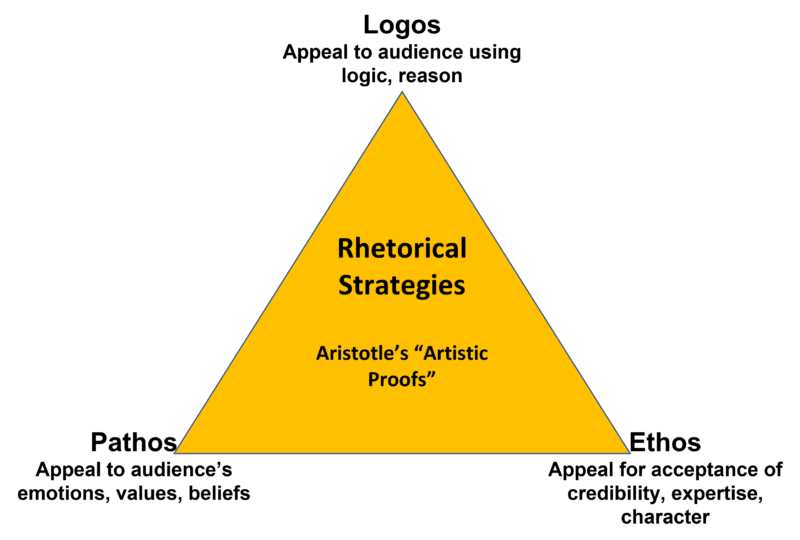
In his 350 B.C. study of persuasive techniques in speech and writing, On Rhetoric: A Theory of Civic Discourse, Greek philosopher Aristotle identifies three strategies to convince an audience to accept a speaker’s (or writer’s) claims: ethos, logos, and pathos. These three strategies constitute the basis for a “rhetorical situation.”
ETHOS
Ethos is the art of convincing an audience that the writer is a credible person of character. That is, the audience trusts the writer to relay reliable facts.
Ethos is essential when a writer is not an expert on a topic. In practice, the writer provides evidence from established experts, thereby showing that the writer is knowledgeable about the topic and credible sources related to it. A writer further establishes credibility by illustrating fairness in understanding and judging facts that support both sides of an argument (claim and counterclaim). The traits associated with ethos—expertise and demonstrating the writer is reliable, knowledgeable, fair, understanding, and unbiased – contribute to authorial credibility, which prompts the audience to pay attention to the writer’s message.
Building ethos
Focus/Purpose
- Weigh facts from both sides to project unbiased judgment
Content Development/Elaboration
- Establish expertise by mentioning degrees and other credentials for the writer and for authors of evidence
- Include opposing viewpoints in counterclaim
Organization
- Include both sides of an argument (claim and counterclaim)
Language Use, Voice, and Style
- Use words associated with the topic (define them if necessary)
- Choose words an audience understands
- Create a tone that illustrates fairness and unbiased judgment
Mechanics/Conventions
- Use error-free grammar, syntax, and punctuation
LOGOS
A second rhetorical strategy for persuasion is logos, which is the art of appealing to the audience using logic, reason, and rationale. When using logos, writers focus on the messages they wish to deliver (claims), the details supporting messages (evidence), the order in which messages and details appear (sequence of an argument), and the links connecting messages. These elements of structure and content guide readers to a logical, rational, reasonable conclusion: the writer’s viewpoint (thesis statement).Building logos
Focus/Purpose- Concentrate on the major points that collectively establish and prove the argument
- Start with a premise (basis) from which everyone can agree
- Use objective evidence, such as facts and statistics
- Break down complicated ideas by comparing them to something simple the audience relates to
- Refer to the work of known experts
- Sequence body paragraphs so that you start with a strong point and end with a strong point, sandwiching weaker points and counterarguments in the middle
- Build an argument with transitions that show connections between key claims
- Use vocabulary associated with the broad idea of a topic, in addition to words that define a narrow point about the topic
- Define key words your audience may not know
- Choose modifying words that will not alienate readers who might disagree with your opinion
- Be sure the tone of writing is acceptable to the audience
- Use a variety of sentence structures to build complex arguments
PATHOS
A third persuasive strategy takes an entirely different approach from logos and ethos. Pathos is an appeal to the emotions of an audience. When using pathos, a speaker or writer attempts to invoke specific emotions to achieve specific actions—that is, to accept the thesis statement is true and to act on that acceptance.
Use of pathos is evident in advertising (a form of persuasion), for example, when the advertisement includes images of smiling farmers exhibiting unrestricted movement and, thereby, supporting claims that a particular brand of coveralls is the most comfortable on the market. Clearly, usage like this equates comfort with the coveralls and draws on the emotion of happiness with the intent of making the audience WANT to buy the coveralls so that they, too, will be happy and comfortable.
Building pathos
Focus/Purpose
- Concentrate on points with which the audience has an emotional tie (values, beliefs)
Content Development/Elaboration
- Provide content that is common (recognizable) and personal (the audience can relate to easily)
- Give examples and details that evoke emotional responses
- Set a “scene” for your audience—that is, create descriptions that move the audience to react emotionally
Organization
- Build to a peak so that the audience’s emotions climb to a “must act” point
Language Use, Voice, and Style
- Use vocabulary that draws out emotions, represents a specific value, or engages imagination
- Be sure the tone of writing aligns with the emotions the writer wishes to bring to the surface in the audience
Mechanics/Conventions
- Use a variety of sentence structures to keep the audience’s imagination engaged